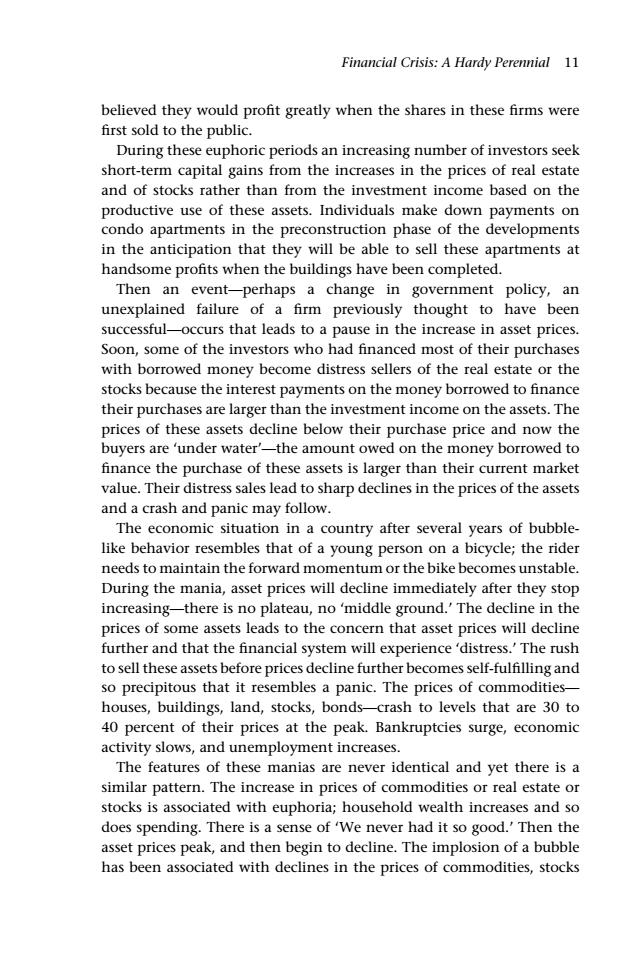正在加载图片...

Financial Crisis:A Hardy Perennial 11 believed they would profit greatly when the shares in these firms were first sold to the public. During these euphoric periods an increasing number of investors seek short-term capital gains from the increases in the prices of real estate and of stocks rather than from the investment income based on the productive use of these assets.Individuals make down payments on condo apartments in the preconstruction phase of the developments in the anticipation that they will be able to sell these apartments at handsome profits when the buildings have been completed. Then an event-perhaps a change in government policy an unexplained failure of a firm previously thought to have been successful-occurs that leads to a pause in the increase in asset prices. Soon,some of the investors who had financed most of their purchase with borrowed money become distress sellers of the real estate or the stocks because the interest payments on the money borrowed to finance their purchases are larger than the investment income on the assets.The prices of these assets decline below their purchase price and now the buyers are 'under water'-the amount owed on the money borrowed to finance the purchase of these assets is larger than their current market value.Their distress sales lead to sharp declines in the prices of the assets and a crash and panic may follow. The economic situation in a country after several vears of bubble like behavior resembles that of a young person on a bicycle;the rider needs to maintain the forward momentum or the bike becomes unstable. During the mania,asset prices will decline immediately after they stop increasing-there is no plateau,no'middle ground.'The decline in the prices of some assets leads to the concern that asset prices will decline further and that the financial system will experience'distress.'The rush to sell these assets before prices decline further becomes self-fulfillingand so precipitous that it resembles a panic.The prices of commodities- houses,buildings,land,stocks,bonds-crash to levels that are 30 to 40 percent of their prices at the peak.Bankruptcies surge,economic activity slows,and unemployment increases. The features of these manias are never identical and yet there is a similar pattern.The increase in prices of commodities or real estate or stocks is associated with euphoria;household wealth increases and so does spending.There is a sense of 'We never had it so good.'Then the asset prices peak,and then begin to decline.The implosion of a bubble has been associated with declines in the prices of commodities,stocksc01 JWBK120/Kindleberger February 13, 2008 14:58 Char Count= Financial Crisis: A Hardy Perennial 11 believed they would profit greatly when the shares in these firms were first sold to the public. During these euphoric periods an increasing number of investors seek short-term capital gains from the increases in the prices of real estate and of stocks rather than from the investment income based on the productive use of these assets. Individuals make down payments on condo apartments in the preconstruction phase of the developments in the anticipation that they will be able to sell these apartments at handsome profits when the buildings have been completed. Then an event—perhaps a change in government policy, an unexplained failure of a firm previously thought to have been successful—occurs that leads to a pause in the increase in asset prices. Soon, some of the investors who had financed most of their purchases with borrowed money become distress sellers of the real estate or the stocks because the interest payments on the money borrowed to finance their purchases are larger than the investment income on the assets. The prices of these assets decline below their purchase price and now the buyers are ‘under water’—the amount owed on the money borrowed to finance the purchase of these assets is larger than their current market value. Their distress sales lead to sharp declines in the prices of the assets and a crash and panic may follow. The economic situation in a country after several years of bubblelike behavior resembles that of a young person on a bicycle; the rider needs to maintain the forward momentum or the bike becomes unstable. During the mania, asset prices will decline immediately after they stop increasing—there is no plateau, no ‘middle ground.’ The decline in the prices of some assets leads to the concern that asset prices will decline further and that the financial system will experience ‘distress.’ The rush to sell these assets before prices decline further becomes self-fulfilling and so precipitous that it resembles a panic. The prices of commodities— houses, buildings, land, stocks, bonds—crash to levels that are 30 to 40 percent of their prices at the peak. Bankruptcies surge, economic activity slows, and unemployment increases. The features of these manias are never identical and yet there is a similar pattern. The increase in prices of commodities or real estate or stocks is associated with euphoria; household wealth increases and so does spending. There is a sense of ‘We never had it so good.’ Then the asset prices peak, and then begin to decline. The implosion of a bubble has been associated with declines in the prices of commodities, stocks